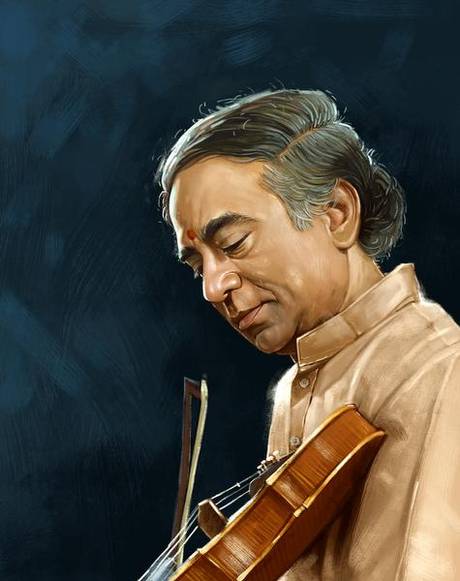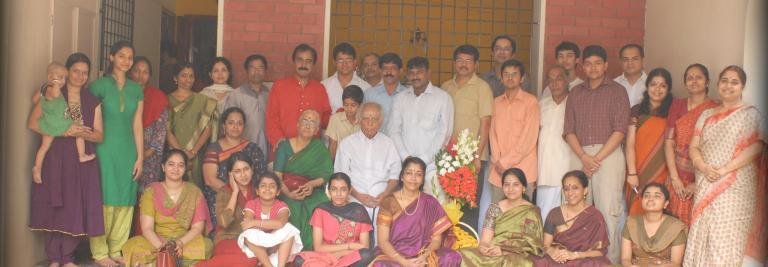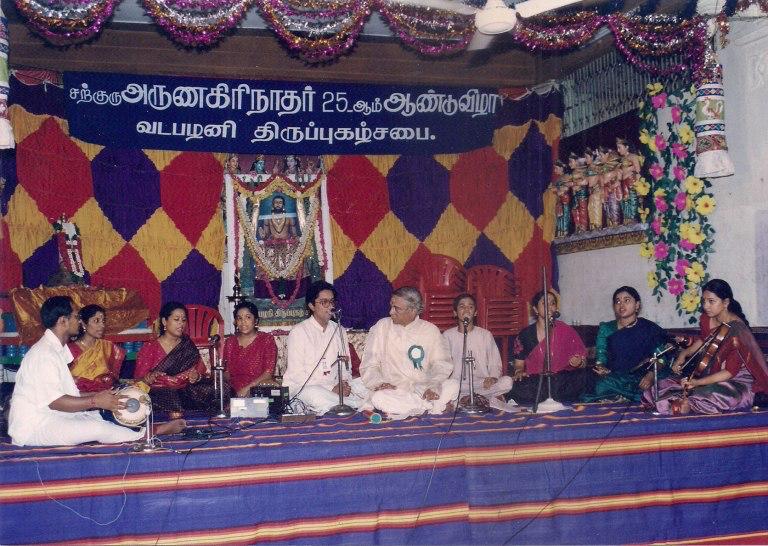Lalgudi G Jayaraman – the Guru par excellence.

A consummate performer rarely makes a good teacher, each requiring different skill sets. Imparting knowledge to those far less conversant requires assessing and customizing instruction for each student, simultaneously motivating and pushing and, above all, zero insecurity to demystify what seems opaque and frequently shrouded. Lalgudi Jayaraman, whose 90th birth anniversary is on September 17th 2020, embodied all these qualities, making him a notable exception in Carnatic music. His legacy is evidenced by the proficiency of not only his children GJR Krishnan and Vijayalakshmi, but several others who are active performers and/or adept teachers themselves.
An edited version of this piece appeared in The Hindu. Art image of Sri. Jayaraman – courtesy The Hindu.

Jayaraman’s advanced pedagogy was particularly noticeable in his incorporating manodharmam into every class (unlike most teachers who insist on several kritis being mastered before initiating the first kalpanAswaram). Vocalist Saketharaman recalls having to sing kalpanAswaram-s for mahA gaNapatim in nAttai at age 9 in his first class!
Maragatham Ramaswamy, an award-winning teacher currently in Virginia, learned briefly from Jayaraman in the 1970s. “Ending kalpanAswaram sequences can be onerous for beginners. He came up with the unique approach of asking students to write down and practice various endings of their own in different counts – 6s and 4s, for example – then to remove one note from each, making the ‘harder’ odd numbered endings easier to concretise.” Vocalist and teacher Vidya Subramanian, who joined Jayaraman as a 12-year-old, adds, “Every round had to finish in that particular ending, even if something else came to tALam. He was teaching us to be in total control.”
He made the abstract AlApana easier to grapple with by depicting it as a narrated story to convey suitable vocalisations, comparing and contrasting ‘piDi-s’ with allied ragas to avoid veering into them, explaining which phrases would and would not work, and referencing kriti-s. Some students were given detailed templates in swaram format, which they could write down.
Jayaraman taught meanings for all songs with instruction that neraval be done only with suitable lines that made sense by themselves, and with repetition. He preferred the phrase ‘sancAri bhAva’ as one was not merely filling but, rather, infusing the selected line with different shades of the raga sensibly. Harikatha exponent Vishakha Hari says, “In ‘paluku palukulaku tEne’ in the Kharaharapriya song rAma nI samAnamevaru, he would add the word ‘sOdharulu’ at the end – to make clear who were speaking the honeyed words. The melody had to befit the word’s meaning too – ‘tEne’ here should ideally sound like dripping honey.”
Pallavi-s and layam aspects were part of class, removing the anxiety both frequently elicit. Students had to compose pallavi-s as homework. In group classes, each attempted the other’s pallavi-s with neraval and tri-kAlam – which he corrected and refined.
Lyrics were sacrosanct with instrumental students too taught through vocal. “Only after we learned the lyric could we play it on the instrument,” says violinist Vittal Ramamurthy. He and Padma Shankar, another violinist, explain that Jayaraman opened their eyes to the soundscape. “Earlier, I could not imagine using certain fingers for certain rAgam-s – the grammar shackled me. He broke them down showing me how to ‘take a photo with the ear’,” says Padma. Vittal states, “He demonstrated that while the notes might be the same for some rAgam-s, how we play them would be very different.”
If a student struggled, notation was used to clarify the phrase. SP Ramh, a senior student of 25 years, and also a vainika, would notate many pieces himself. For others, Jayaraman would either write it for them or ask them to copy it down.
Listening to stalwarts’ recordings is always stressed but exactly what one should listen for is frequently unclear. Jayaraman would play concert recordings of the masters in class, encouraging students to identify notable aspects whilst guiding them.
To expand the mind to receive the nuances of music, riddles and puzzles, making kites and telling jokes were part of class. Jayaraman appreciated all art forms and was a constant learner. Ramh remembers exposure to other styles of music, listening to ghazal-s and Hindustani music in class. There were excursions to other towns, the beach on full moon day, magic shows, Hindustani concerts etc. Maragatham and Vidya recollect Jayaraman’s own beautiful line drawings, particularly of elephants.
He took keen interest in his students’ careers. Vittal recollects his AIR audition and how Jayaraman taught concertedly to ensure its success. He analysed their concerts in the minutest detail either attending or listening to the recordings. Criticism always came first but appreciation was unfailingly conveyed.
He imparted concert ethics beyond the basics. He adviced violinists to be cognisant of days when co-artiste(s) might be off their best and to play so as not to show them up. Vocal performers were told to inform violin and percussion artistes, and demonstrate as needed, if anything unconventional was being planned.

Ramh says, “Lalgudi mama would ask us to analyse our own performance as a third party and insisted we take notes of every mistake or “it would, literally, be gone with the wind”. He stressed the importance of musicians being rasika-s.”
Jayaraman gave his all and expected perfection from his students. Vittal Ramamurthy says, “It always had to be 100%. The question of 99% did not exist.” Padma Shankar adds, “He had more belief in his students than we often did in ourselves.” From being in absolute timely readiness for every class to assisting students in financial difficulties, Lalgudi Jayaraman demonstrated total commitment to every aspect of holistic teaching.
A Holistic Teacher as rightly mentioned, for we are able to identify His bani even at the start of the first stroke of swaras by an artist even today , and an artist par Superlatives. His music helps the listener in transcending . Feeling blessed to have attended many of his New Year’s day concerts in Mylapore Fine arts!
Very nice write-up! The videos made me feel emotional and nostalgic!
Excellent write up! One of my most favourite violinists of yesteryears! His honey sweet playing is an unique style! Great write up from Ms Lakshmi, as usual!
Excellent writeup.
Enjoyed reading your article. Very clear explanations and excellent as usual.